If you’ve never made your own yogurt you’re missing out! Not only is it delicious it is also very healthy, especially when using the following recipe. Yogurt is also quite simple to make.
It is possible to make yogurt from Phage Complete, but I now recommend that you use l. reuteri instead. The phages in Phage Complete do not benefit from fermentation (phages don’t consume milk), and they may even be deactivated (moisture will first activate them, then the fermentation process may then destroy them).
This recipe uses two l.reuteri probiotic strains that have shown numerous benefits in several research studies (more on this below). When consumed with Phage Complete the l.reuteri will benefit from the amplification effect of the phage complex! This means that the l. reuteri will continue to replicate in your gut, and show benefits to the very end of the colon (where normally this bacteria will die before it reaches the end of the colon. Not so when taken with Phage Complete). Note: According to an obscure study in mice1DOI: 10.1016/j.chom.2018.11.009, L.reuteri (and thus this yogurt) should not be consumed by a person with Lupus. If you have MCAS be sure to see the footnote at the end of this document.
So just how easy is this to make? It takes me about 10 minutes to mix everything together, and then less than 5 minutes at the end to scoop it all into a container. The actual fermentation takes 20-24 hours, but that requires no effort on your part (the probiotic bacteria do all the work; actually they just have a nonstop orgy and replicate, not sure I would call that work). This document is a little wordy, but I’m mixing in education with directions. This recipe is loosely based on Dr. William Davis’ 2of Wheat Belly fame recipe, but with several changes and (IMHO) improvements. 3 You can find his original recipe here. https://www.wheatbellyblog.com/2019/07/how-to-make-l-reuteri-yogurt-step-by-step/
Note: Your first batch of yogurt will be a little thinner and have a slightly odd taste; this is because the probiotic capsules have far less starter bacteria than the whey will have and they have a mild artificial fruit flavor (that does not taste good after fermenting). When eating that first batch I cover up the flavor with maple syrup or jam and far less noticeable; you, on the other hand, may take one bite and decide to throw it away. Subsequent batches will not have this issue as they’re made from the whey of previous batches and your yogurt will taste great!
Table of Contents
What You’ll Need
- A yogurt maker of some kind. You want one that you can control the temperature, and having one that you can set the time is preferred. This is the successor to the one that I use and mine works great! Very simple to use, even temperature, and inexpensive. Keeping the temperature below 112°F is important and that is easy with this yogurt maker. 4 I’ve monitored the temperature of both the water well and the yogurt using a multisensor bluetooth thermometer that graphs it on my phone. Temperatures do vary a little but not excessively.
- 4-6 cups of milk (I use organic lactose free grassfed whole milk). Check to see how much milk you need for your yogurt maker. Lactose free is best, but you can also make regular milk lactose free using lactase drops. Lactose free milk has the same amount of sugars as regular milk, the lactose simply gets converts to glucose and galactose. This makes it easier for both you and the l.reuteri bacteria to digest it. 5The recipe can be halved if you want. Non-dairy milks such as almond or flax should also work, but it won’t be as thick, creamy and delicious. You’ll also be missing out on the vitamin K2 from the grassfed whole milk.
- L.reuteri starter. The first time you make it you’ll need to use BioGaia tablets; crush 15 of these (a mortar works the easiest, but what ever works for you. It should be a fine powder similar to course sea salt). In the future you’ll use 3 tbsp of the whey (for 6 cups, 2 Tbsp for 4 cups) from the last batch so you may only need to purchase the BioGaia once. The first batch of yogurt may be a little weak, but subsequent batches will be fine.
- Soluble fiber – at least one of the following: Larch Tree Arabinogalactan, Acacia Senegal (also known as Gum Arabic), and Partially Hydrolyzed Guar Gum (PHGG). 6Dr. Davis’ original l.reuteri yogurt used inulin probiotic powder; I do not recommend this as it is a strong FODMAP that can cause many people to have excessive gas, bloating, and sometimes diarrhea. Not all of the inulin will be consumed by the bacteria during fermentation.
- Gelatin powder – I use a good quality gelatin from grassfed cows. 7You can leave this out if you’re on a vegan type diet. However, it really adds to the quality of the yogurt and provides its own health benefits. This is key to getting a smooth / silky yogurt.
- Large coffee filters (I use 1.5 gallon Bunn filters)
- Mixing bowl or large measuring cup. I use this Anchor 2 quart measuring bowl.
- Whisk or long wooden spoon
- Colander
Optional
-
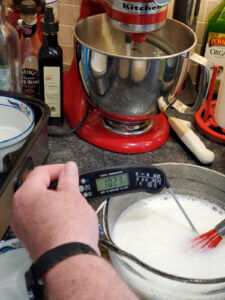
Milk Temperature Two or more types of soluble fiber from the list above; you can also add Modified Citrus Pectin for extra health benefits.
- Food thermometer
- Two 6″ ramekins or heat safe storage containers. 8I use 2 ramekins that are 3″ tall and 6″ in diameter to make our yogurt. They fit just perfect in the yogurt maker and is easier than using the little cups that came with it. I’ve also used 6″ Rubbermaid glass storage containers before but they were too tall. As long as its ceramic or heat safe glass and fits in your yogurt maker it will be okay. Just measure how much liquid they’ll hold and adjust the recipe accordingly.
Recipe / Directions
- Pour two cups of warm tap water (100-110°F) into the yogurt maker well. Set the yogurt maker to 104°F and set the timer for 20-24 hours (I use 22 hours). 9The longer the time the more acidic (tangy) the yogurt will be. I do not like using more than 24 hours as it becomes too acidic and can actually cause some intestinal distress. I’ve found that 22 hours works very well and it still has plenty of l. reuteri CFUs
- Pour 4-6 cups of lactose free whole milk (or non-dairy milk if you must) into a microwave safe bowl (I use the 2 quart measuring bowl). Microwave 6 cups for 3 minutes 40 seconds, or 4 cups for 3 minutes 20 seconds. The milk temperature should be between 100-112°F. If its too warm whisk it until the temperature comes down.
-
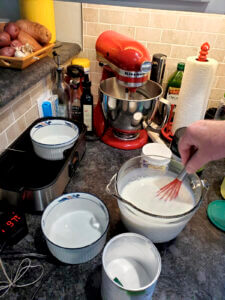
Whisking the Ingredients Add 2 in Tbsp of soluble fiber (e.g. larch tree, or a mix of soluble fibers) into the warm milk, whisk until mixed. If available you can also add 2 scoops of Modified Citrus Pectin (in addition to the other fiber). (4 cups use 1 1/2 Tbsp)
- Add 2 in Tbsp gelatin and whisk (4 cups use 1 1/2 Tbsp)
- Add 3 level Tbsp of starter whey (or the 15 well crushed BioGaia tablets) and whisk (4 cups use 2 1/2 Tbsp, or 12 tablets)
- Pour or ladle the milk mixture in to the ramekins. Gently put the ramekins into the water well and put the yogurt maker’s lid in place.
- Check every 2-4 hours for condensation build up on the inside of the lid. If it is forming drops remove the lid, carefully take to the the sink and pour it off (then shake the lid a few times to get even more off). 10Do not use a sponge to remove the condensation as it can harbor bacteria.
Straining the Whey
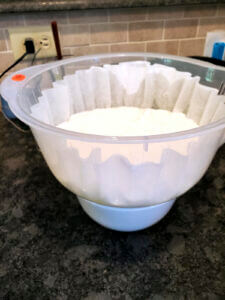
Once the timer goes off its time to drain the whey (the liquid part of milk). This thickens the yogurt and improves the silky tongue feel. If you have another way that you like to strain your yogurt that is perfectly fine. Some people may want to people skip this step but I advise to do it. 11Whey is very insulinogenic (causes insulin spikes), even more so that sugar! The spikes in insulin are not only bad for your health, but they can trigger diarrhea in some people and cause weight gain. They can also cause hypoglycemia (low blood sugar) which can then cause people to consume sugar to improve their insulin levels (sugar feeds bad bacteria).
- Line the inside of a colander with 2 of the large coffee filters
- Put a bowl under the colander to catch the whey. Its best that the colander doesn’t fit completely into the bowl.
- Dump the yogurt from the ramekins into the coffee filters
- Put a plate or plastic wrap over the top of colander
- Put the whole thing into the refrigerator for 4-8 hours 12generally 4 is enough, but if you want to leave it in there overnight that is fine
- Remove from the refrigerator and scoop the yogurt in to a storage container, put the lid on it and refrigerator until you’re ready to eat it. It will last at least 2 weeks in the refrigerator (mine is consumed long before that)
- Keep 1 pint of fermented whey on-hand in the refrigerator for the next few batches. Toss out when its over 2 weeks old and replace with new. 13You’ll find that this whey will look like jello because of the added gelatin. You can also feed a little to your dog or cat, though no more than 1/2 cup per day as it will be more acidic than normal due to fermentation
After refrigeration the yogurt comes out thick, silky and delicious every time! Both my wife and I love it and have it everyday.
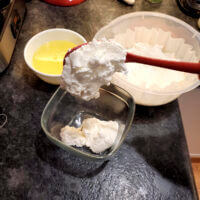
Topping / Stir-in Ideas
- Stevia / Monkfruit (preferably with no erythritol)
- No sugar added jam or jelly (especially make sure it has no high fructose corn syrup)
- Peanut / almond butter – all natural is best
- Nutella Hazelnut spread (believe it or not it has no HFCS, does have sugar though)
- 1/8 – 1/4 tsp of vanilla extract
- Blueberries / Strawberries
Benefits of L.Reuteri Yogurt
- L. reuteri can produce antimicrobial molecules, such as organic acids, ethanol, and reuterin 14The next 5 bullets are from PubMed ID#PMC5917019
- L. reuteri is able to inhibit the colonization of pathogenic microbes and remodel the commensal microbiota composition in the host.
- L. reuteri can benefit the host immune system
- L. reuteri strains can reduce the production of pro-inflammatory cytokines while promoting regulatory T cell development and function.
- L. reuteri can strengthen the intestinal barrier and decrease microbial translocation (e.g. can help repair leaky gut). It can also help prevent lipopolysaccharide from crossing into the systemic environment 15Microbial translocation across the intestinal epithelium has been hypothesized as an initiator of inflammation. Therefore, inflammatory diseases, including those located in the gut as well as in remote tissues, may be ameliorated by increasing the colonization of L. reuteri..
- L. reuteri up-regulates oxytocin. This has many benefits, including speeds wound / skin healing, improves social bonding, energy metabolism, and wound healing contributing to good physical, mental and social health, lowers corticosterone. Oxytocin contributes to the maturation and selection of T-lymphocytes in the thymus.16 See the following study for much more on the benefits of oxytocin and L. reuteri’s ability to up-regulate it. PubMed ID#https://www.ncbi.nlm.nih.gov/pmc/articles/PMC5431580/
- Sustain youthful serum testosterone levels and libido 17The reduction of testosterone has been implicated in many adverse effects of aging in men, including reduced spermatogenesis, libido and sexual function, increased body fat, decreased muscle and bone mass, low energy levels, fatigue, poor physical performance, depressed mood, and impaired cognitive dysfunction. PubMed ID#PMC3879365
- L. reuteri converts inflammatory type dietary histamine into a form that reduces inflammation and is good for us. 18“a component of the gut microbiome, L. reuteri, is able to convert a dietary component, L-histidine, into an immunoregulatory signal, histamine, which suppresses pro-inflammatory TNF production.” — PubMed ID#PMC3285189 .
Note: If you have MCAS / Histamine Intolerance please see this info. 19There is a lot of conflicting information as to whether a person with MCAS can consume L.reuteri. This yogurt produces a very high CFU yogurt and is quit medicinal for most people. But if you think you have MCAS I recommend proceeding with caution, only do a 14-16 hour ferment and start by consuming 2-4 Tbsp per day. Because of the type of histamine it produces your symptoms may be different than what you are use to and may take several days to develop. People without MCAS should have nothing to worry about. - Helps treat and prevent UTIs. 20“Lactobacillus rhamnosus GR-1 and L. reuteri RC-14 (previously called L. fermentum RC-14) seemed to be the most effective among the studied lactobacilli for the prevention of UTIs.” — PubMed ID#16827601
“they found evidence that Lactobacillus species (particularly L. rhamnosus GR-1 and L. reuteri) may be useful in the prevention and treatment of recurrent UTIs. ” — PubMed ID#PMC6134985
Combine the benefits of L. reuteri with that of the gelatin and you can see just how healthy this yogurt can be. Combine this with the amplification effect of Phage Complete for even more benefits!
[print-me]
| These statements have not been evaluated by the Food and Drug Administration. This product is not intended to diagnose, treat, cure, or prevent any disease. |
All images posted by John Herron are either "Copyrighted John Herron", or are copyrighted by someone else and are used under license. So please don’t use them elsewhere, you’ll get in trouble.
- 1DOI: 10.1016/j.chom.2018.11.009
- 2of Wheat Belly fame
- 3You can find his original recipe here. https://www.wheatbellyblog.com/2019/07/how-to-make-l-reuteri-yogurt-step-by-step/
- 4I’ve monitored the temperature of both the water well and the yogurt using a multisensor bluetooth thermometer that graphs it on my phone. Temperatures do vary a little but not excessively.
- 5The recipe can be halved if you want. Non-dairy milks such as almond or flax should also work, but it won’t be as thick, creamy and delicious. You’ll also be missing out on the vitamin K2 from the grassfed whole milk.
- 6Dr. Davis’ original l.reuteri yogurt used inulin probiotic powder; I do not recommend this as it is a strong FODMAP that can cause many people to have excessive gas, bloating, and sometimes diarrhea. Not all of the inulin will be consumed by the bacteria during fermentation.
- 7You can leave this out if you’re on a vegan type diet. However, it really adds to the quality of the yogurt and provides its own health benefits. This is key to getting a smooth / silky yogurt.
- 8I use 2 ramekins that are 3″ tall and 6″ in diameter to make our yogurt. They fit just perfect in the yogurt maker and is easier than using the little cups that came with it. I’ve also used 6″ Rubbermaid glass storage containers before but they were too tall. As long as its ceramic or heat safe glass and fits in your yogurt maker it will be okay. Just measure how much liquid they’ll hold and adjust the recipe accordingly.
- 9The longer the time the more acidic (tangy) the yogurt will be. I do not like using more than 24 hours as it becomes too acidic and can actually cause some intestinal distress. I’ve found that 22 hours works very well and it still has plenty of l. reuteri CFUs
- 10Do not use a sponge to remove the condensation as it can harbor bacteria.
- 11Whey is very insulinogenic (causes insulin spikes), even more so that sugar! The spikes in insulin are not only bad for your health, but they can trigger diarrhea in some people and cause weight gain. They can also cause hypoglycemia (low blood sugar) which can then cause people to consume sugar to improve their insulin levels (sugar feeds bad bacteria).
- 12generally 4 is enough, but if you want to leave it in there overnight that is fine
- 13You’ll find that this whey will look like jello because of the added gelatin. You can also feed a little to your dog or cat, though no more than 1/2 cup per day as it will be more acidic than normal due to fermentation
- 14The next 5 bullets are from PubMed ID#PMC5917019
- 15Microbial translocation across the intestinal epithelium has been hypothesized as an initiator of inflammation. Therefore, inflammatory diseases, including those located in the gut as well as in remote tissues, may be ameliorated by increasing the colonization of L. reuteri.
- 16See the following study for much more on the benefits of oxytocin and L. reuteri’s ability to up-regulate it. PubMed ID#https://www.ncbi.nlm.nih.gov/pmc/articles/PMC5431580/
- 17The reduction of testosterone has been implicated in many adverse effects of aging in men, including reduced spermatogenesis, libido and sexual function, increased body fat, decreased muscle and bone mass, low energy levels, fatigue, poor physical performance, depressed mood, and impaired cognitive dysfunction. PubMed ID#PMC3879365
- 18“a component of the gut microbiome, L. reuteri, is able to convert a dietary component, L-histidine, into an immunoregulatory signal, histamine, which suppresses pro-inflammatory TNF production.” — PubMed ID#PMC3285189
- 19There is a lot of conflicting information as to whether a person with MCAS can consume L.reuteri. This yogurt produces a very high CFU yogurt and is quit medicinal for most people. But if you think you have MCAS I recommend proceeding with caution, only do a 14-16 hour ferment and start by consuming 2-4 Tbsp per day. Because of the type of histamine it produces your symptoms may be different than what you are use to and may take several days to develop. People without MCAS should have nothing to worry about.
- 20“Lactobacillus rhamnosus GR-1 and L. reuteri RC-14 (previously called L. fermentum RC-14) seemed to be the most effective among the studied lactobacilli for the prevention of UTIs.” — PubMed ID#16827601
“they found evidence that Lactobacillus species (particularly L. rhamnosus GR-1 and L. reuteri) may be useful in the prevention and treatment of recurrent UTIs. ” — PubMed ID#PMC6134985

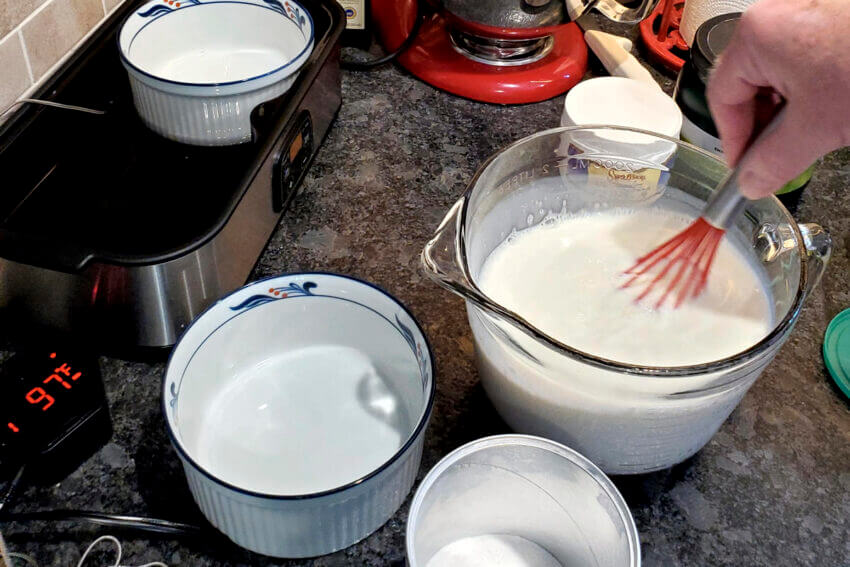
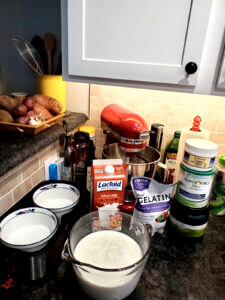
 Phage Complete comes with a full 30 day money back guarantee, for U.S. purchases this includes the original shipping charges to you!
Phage Complete comes with a full 30 day money back guarantee, for U.S. purchases this includes the original shipping charges to you!